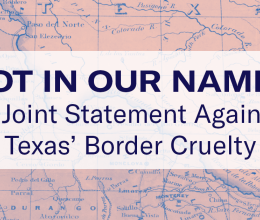
For more than two years, the immigration debate has revolved around one issue: “the border.”
Despite the fact that issues related to the border are vast and complex, the entire U.S. immigration system – flaws and all – has been boiled down to grainy images of barbed wire atop a border wall and videos of families and others seeking safety waiting for a chance to make their asylum claims.
Our current election cycle has only magnified and intensified the problem. At the ACLU, we examined three ways the media is shaping unfair narratives about the immigration system:
ONE: Millions of dollars have been funneled into political ads based on fearmongering about the border
Candidates across the political spectrum have spent hundreds of millions of dollars over the last year doing everything in their power to distill the immigration debate down to the lowest common denominator—making people afraid of what’s happening at the southern border—facts and truth be damned.
We evaluated the entire $247 million spend on immigration ads and found that:
- More than a third of the 745 ads included depictions of Border Patrol agents, soldiers or the military, which contribute to the false idea of a militarized “battle zone” at the border.
- Around 20 percent of the ads referred to migrants as “illegals” or “aliens,” with around seven percent choosing harsher words like “trafficker,” “rapist,” or “murderer.”
- Around 10 percent of the 745 ads referenced migrants as invaders or the influx of migrants as an invasion.
TWO: Media often pairs immigration news with chaotic images from the border, regardless of the connection
Mainstream media willingly or unwittingly plays into this obsession with the border by accompanying any media reporting on immigration, no matter how tenuous or absent the connection, with scenes from our southern border. As Media Matter chronicles in a recent piece, multiple mainstream media companies when discussing President Joe Biden’s new program, Keep Families Together, which allows the spouses of U.S. citizens a path to legalization, didn’t show images of the American families that would actually be helped by the policy, but instead showed images and videos of cars and people lined up at the border.
THREE: The news cycle is hyper-focused on the border, often overlooking other immigration stories
Mainstream media organizations often ignore larger immigration stories in favor of hyper-focusing on the border. We saw this most prominently during the September 10th presidential debate. Although ABC’s David Muir did fact check atrocious false claims made about community members in Springfield, Ohio, this was a surprising shift in efforts to hold candidates accountable for falsehoods, and Muir still used his one question about immigration as a smoke screen to only discuss border security.
While border security is but one part of our immigration system, the larger parts are too often ignored by the media. While the U.S. continues to receive new migrants, millions of immigrants already here have become our friends, family members, and integral contributors to our communities and economy. In fact, earlier this year, three separate nonpartisan research groups released studies making the case that immigration played a significant role in preventing a recession last year. Unfortunately, these stories are nowhere to be seen on the nightly news.
Today, even as voters are bombarded from all sides with chaotic images from the border, misleading ads with scary videos and deceptive messages and a media landscape that is seemingly obsessed with the border their views remain nuanced, a majority of Americans still see immigration as a good thing for the country. That aligns with recent polling from the ACLU that shows that what American voters actually want is to hear about balanced and humane approaches to immigration that both manage challenges at the border and include a pathway to citizenship for our longtime neighbors.
For six months, the ACLU has met with actors on both sides of the political spectrum to make the case that voters are hungry for their leaders to talk about real solutions and that appealing to the lowest possible denominator will only exacerbate the problem. Imagine where public opinion might be today if instead of hundreds of millions of dollars spent to make people afraid of immigrants, we had seen hundreds of millions of dollars spent uplifting the stories of the six immigrant workers who lost their lives while working to repair our bridges in Baltimore? Or of all the small businesses employing thousands of workers opened by immigrants? Or of the immigrants taking on essential care in nursing homes, daycares, and hospitals?
The ACLU has consistently advocated for common-sense solutions that will help modernize our immigration system without sacrificing our nation’s laws and moral obligation to protect people seeking a better life. That includes policies that would improve processing at ports of entry and hire more personnel to reduce the immigration case backlog. It also means passing solutions that will protect our immigrant neighbors who have built businesses and families in the U.S., such as by providing a pathway to citizenship for Dreamers and other longtime residents. Above all, we need politicians to show some political courage and willingness to lead based on their values rather than through fearmongering.






